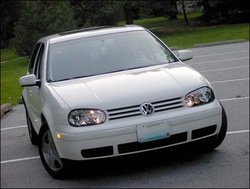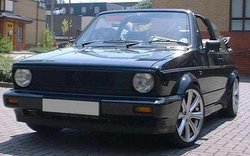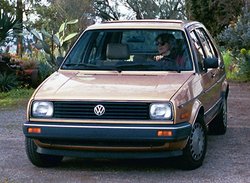VW Golf
|
|
The Volkswagen Golf is an automobile manufactured by Volkswagen. The Golf is Volkswagen's best-selling model in history, with more than 22 million built as of 2003. Considering cars that keep their concept and basic layout (and not only their name) the VW Golf is the best selling car of all times worldwide.
Most production of the Golf has been in the 2-door hatchback style. 4-door hatchback, station wagon (estate) and convertible variants have also been available, as well as a sedan (saloon) car based on the Golf (see VW Jetta). They have existed everywhere between basic personal cars and high-performance sports coupes.
Currently, Volkswagen is transitioning from production of the Golf IV toward the V version. Options for engine and transmission vary from country to country, but the Golf is available in 4-cylinder and VR6 gasoline-powered versions and turbo direct injection diesel-engined models in most places, with transmission options that include manual, automatic, Tiptronic, and direct shift gearbox.
| Contents |
History
The Golf is an historically important automobile, as it has been in continuous production from 1974 until the present day. It was responsible for the mass-market acceptance of the hatchback design and created the concept of a hot hatch. The Golf was also a crucial model for VW itself; by the early 1970s the company was in serious financial trouble; Beetle sales were in terminal decline, and car buyers increasingly turned away from VW's quirky aircooled, rear-engined models. The Type 3 and Type 4 failed to attract any interest, whilst the NSU-developed K70 was an unmitigated disaster. The saviour of the German car giant came in the form of Auto Union, which owned the famous Audi brand. VW had acquired the Ingolstadt company in the mid 1960s from Daimler-Benz, and crucially gained access to Audi's expertise in water cooled engines and front wheel drive which were needed to produce a new generation of Volkswagens. The Golf was the central product of this new strategy.
Golf I (1974–1983)
The first Golf began production in 1974. Marketed in the United States from 1975 to 1984 as the Volkswagen Rabbit, it featured the water-cooled, front transverse-engine, front wheel drive design pioneered by the Mini with the addition of a hatchback, revolutionizing small car design and manufacture. The Golf was Wheels magazine's Car of the Year for 1976.
While the Golf was not the first design with this layout (that honour going to the Fiat 128 3P of the early 1970s), it was the first to be successful in the mass market, and it was the VW, rather than the Fiat, that was widely copied.
The Golf was designed by Italian automobile architect / designer Giorgetto Giugiaro, of the ItalDesign design studio. A version of this original Golf model, known as the VW Citi, is still produced in South Africa as an entry level car.
The GTi version, launched in Europe 1977 and the US in 1983, created a whole new type of car, the hot hatch, and was widely copied by all other manufacturers since. In 2004, Sports Car International named the Rabbit GTI number three on the list of Top Sports Cars of the 1980s.
The convertible, named Golf Cabriolet and Rabbit Convertible, was sold from 1980 to 1993. It had a reinforced body, transverse roll bar, and a high level of trim. Golfs were literally delivered to Karmann to have their tops cut off. The vinyl tops were insulated and manually operated, with a glass rear window.
Golf II (1983–1991)
The second-generation Golf was launched in 1983 (launched in North America in 1985) and featured a larger bodyshell and a wider range of engine options, including a turbo-diesel, a DOHC 16-valve version of the straight-four GTi (as well as the tried and tested 1800 8v GTi), the supercharged 8v "G60" and a homologated variant of this, the "Rallye".
A very limited edition hand-built Golf II variant exists, including all of the best features available at the time. Designed and built by the Volkswagen Motorsport division, only 71 of these "G60 Limited" models exist; featuring a unique number and plaque, the G60 supercharger was combined with the 16-valve GTi engine, mated to a sports transmission and Syncro four-wheel-drive mechanism. All of these special edition models came in black, with four doors (except two in three door), a plain two-headlamp grill (not the usual GTi four headlamps) and a unique blue grille detail (not red, as the GTi) and motorsport badges. It is rumoured that two models were produced with air conditioning. In 1989, these cars cost in the region of £25,000 each and were primarily sold to VAG executives and management, although a few exist in Britain to date (2004).
There was also a version called Golf Country, designed for light off-road driving. It had more suspension travel, four-wheel drive, bullbars, a skidplate for protecting the engine area, and a spare wheel mounted externally on the back.
The GTI was Motor Trend magazine's Car of the Year for 1985.
Golf III (1991–1998)
The third-generation Golf was launched in 1991, although it did not appear in North America until 1993. The third-generation Golf was elected Car of the Year in 1992. For the first time a station wagon derivative was produced. The GTi variants (especially with the straight-four 4 cylinders engine) are considered to be the poorest of the performance Golfs, with significantly increased weight, but with minimal power increases. A "best of breed" VR6 variant exists which was available in a well regarded "Highline" trim. The convertible version was called the Cabrio in the United States.
Golf IV (1998–2003)
The Golf IV was the heaviest, largest and slowest version to date, but still became the biggest selling car in Europe at one point. It was a deliberate attempt to take the Golf further upmarket, with a high-quality interior and higher equipment levels.
The Golf IV was made in Germany, Slovakia, Brazil and Belgium.
Engine choices included 1·4, 1·6, 1·8, 2·3 and 2·8 L petrol engines, and a 1·9 L diesel. A choice of two- and four-door hatchback or five-door station wagon was available.
This model was introduced to North America in mid 1999. Available engines were a 2.0L gas, 1.9L turbocharged diesel TDI. A 1.8L turbocharged gas engine was introduced in 2000, along with the 2.8L VR6.
20th Anniversary Edition (2003)
StockSide001.jpg
Due to the popularity of a commemorative 25th anniversary edition GTI produced in Europe, VWOA produced 4000 so-branded '20th Anniversary Edition' GTIs and shipped them to the United States. This event, in 2003 marked the 20th anniversary of the Golf's first introduction to the US, then called the Rabbit. Several special features distinguish this new GTI from the rest of the pack.
On the outside, the 20th comes with throwback red-letterd 'GTI' logos on the left front and right rear. The rear is also accompanied by a vintage-look chrome rabbit. Blackened headlights and dark-tinted tail lights add a distinctive look, while Votex front, rear, and side skirts along with a hatch spoiler and special edition 18" OZ Aristo alloy wheels complete the exterior transformation. These models were produced in three colors: Imola Yellow, Jazz Blue and Black Magic Pearl.
Inside, a few accents are noticable. Unlike other models, there are no 'options' available. The only true option is ESP, Volkswagen's stability control feature. All 20ths have a sunroof, leather steering wheel and emergency brake handle, and sporty black cloth Recaro bucket seats with red stitching accents and red 'GTI' emblem embroidered in the middle of the back rest. Aluminum trim comes standard, complete with a numbered namaplate above the center console identifying the exact production number (1-4000 for the US, 1-500 for Canada) of the vehicle. Volkswagen's premier 8-speaker Monsoon(tm) stereo system is also standard.
Mechanically speaking, this is your average GTI 1.8T with a few exceptions. A 6-speed manual transmission marks the most notable departure from the norm, and upgraded suspension stiffens up the ride and lowers the car approximately 40mm. Upgraded disc brakes front and rear help bring things to a stop, while the red-painted calipers add a bit of flair to the whole package.
Golf R32(2003-2004)
R323sm.jpg
In 2003 VW produced the Golf R32 in Europe. Again, due to unexpected popularity VW (thru VWOA) decided to sell the car in North America (except Canada) as the 2004 VW R32. Billed as the pinnacle of the Golf IV platform the R32 included every performance, safety, and luxury feature VW had to offer including the all new 3.2l VR6 engine, AWD, a new 6-speed gearbox, independent rear suspension, automatic climate control, sport seats from Koenig, 18-inch OZ Aristo wheels, ESP, massive (334mm) brakes, sunroof, and model specific bodywork.
In spite of outwardly appearing very similar to the 20th Anniversary GTI the R32 shares the vast majority of its major components with the 3.2l Audi TT. 5000 cars were produced and intended to be sold over a 2 year period. Each car was sold just 13 months later.
The Golf R32's closest competitors (at the time of production) were the Subaru Impreza WRX STi and the Mitsubishi Lancer Evolution VIII, although unlike those Japanese cars, the R32 is not run by Volkswagen in rally competitions.
The Official R32 FAQ: [1] (http://forums.vwvortex.com/zerothread?id=1285689)
Golf V (2003–)
Golf5i.jpg
The fifth generation started to sell in November 2003. For the presentation of the new Golf, Wolfsburg was renamed to Golfsburg for a week. It is expected to appear in the United States in early 2006 (model year 2006½ or 2007). The GTI features Fuel Stratified Injection, turbo charging and DSG gearbox.
In December, 2004, Volkswagen announced the Golf Plus variant of the Golf V. It is taller than the "regular" Golf but shorter than the Touran, the MPV version of the Golf. Volkswagen intends to release the Golf Plus in the United Kingdom in the summer of 2005. The Golf Plus would also be available elsewhere in Europe, possibly at the same time.
It is rumored that a Golf V successor to the R32 could be made, probably in 2006, and that it might have a twin-turbocharged 300 hp V6 and AWD.
- More information is available on the Golf V GTI at http://www.mk5gti.com
Variants
The sedan version of the Golf was the Jetta, subsequently known as the Vento (from 1992) and later as the Bora from 1998, although the Jetta name is still used in North America and South Africa.
The Golf shares the Volkswagen A platform with a number of other Volkswagen Group products including the Audi TT.
External links
- http://www.mk5gti.com - The largest MK5 GTI Site on the Net.
- VW Golf (http://www.vw.com/golf/) – Official site
- http://dmoz.org/Recreation/Autos/Makes_and_Models/Volkswagen/Golf/
- http://www.vwvortex.com - The largest VW Community on the Net.
Volkswagen Group
| ||
| Volkswagen | Audi | SEAT | Škoda | Bentley | Bugatti | Lamborghini
| ||
| Apollo | Lupo | Polo | Gol | Citi/CitiGolf | Golf | Jetta/Vento/Bora | Fox/Gacel | Scirocco | Corrado | Beetle/Bug | TL/Varient | Touran | K70 | Passat | Santana | Sharan | Phaeton | Pointer | Quantum | Touareg | Caddy | Eurovan/Transporter | LT | ||
| Beetle (Type 1) | Bus/Transporter (Type 2) | 1500/1600 (Type 3) | 411/412 (Type 4) | Karmann Ghia | Kübelwagen | Schwimmwagen | 1-litre concept | ||
| Edit this template (http://en.wikipedia.org/w/wiki.phtml?title=Template:VW&action=edit) | ||
hr:Volkswagen Golf no:Volkswagen Golf pl:Volkswagen Golf sv:Volkswagen Golf



